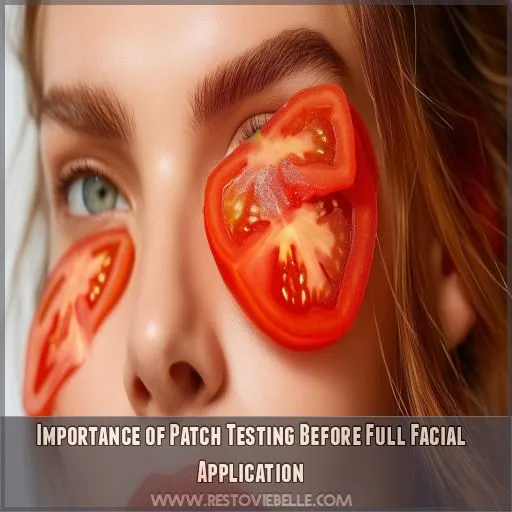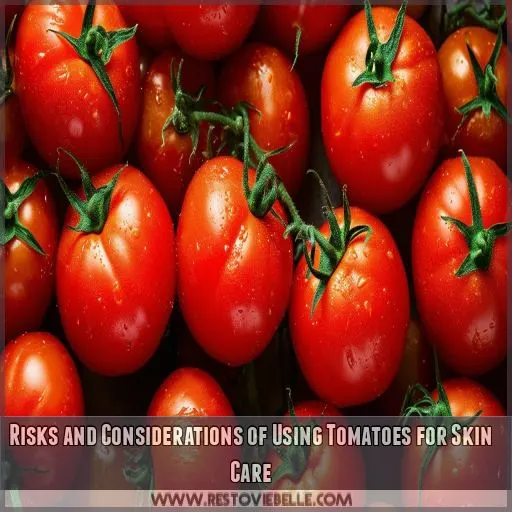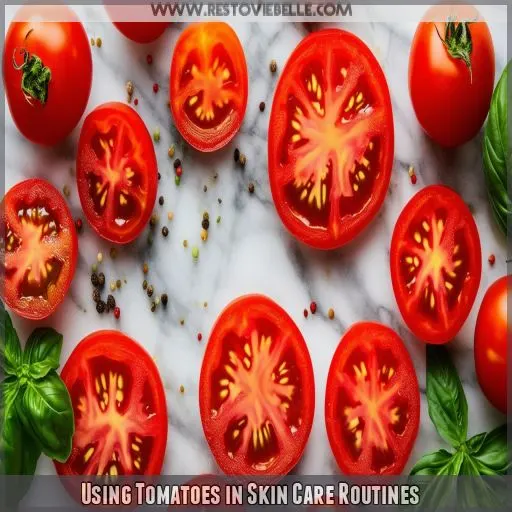This site is supported by our readers. We may earn a commission, at no cost to you, if you purchase through links.

This powerhouse fruit helps in controlling acne, reducing oil production, and even treating sunburns.
Explore the benefits of tomato for skin, face, and hair and discover how this humble everyday ingredient can be a game-changer in your beauty routine.
Table Of Contents
- Key Takeaways
- Benefits of Applying Tomato on the Face
- Side Effects of Applying Tomato on the Face
- How to Apply Tomato on the Face?
- Best Ways to Use Tomato on Your Face
- How Often Should You Apply Tomato on the Face?
- Is Tomato Good for Facial Hair?
- Can You Apply Tomato on the Face?
- Importance of Patch Testing Before Full Facial Application
- Risks and Considerations of Using Tomatoes for Skin Care
- Using Tomatoes in Skin Care Routines
- Frequently Asked Questions (FAQs)
- What if I rub tomato on my face everyday?
- Is tomato good for facial hair?
- Is tomato good for your face?
- How long should I leave tomatoes on my face?
- Can tomatoes help with scalp health?
- How do tomatoes benefit sun-damaged lips?
- Are green tomatoes safe for skin care?
- Can tomato juice improve dark circles?
- What nutrients in tomatoes promote hair growth?
- Conclusion
Key Takeaways
- Tomatoes act as nature’s red gem, offering a plethora of benefits for your skin, face, and hair.
- The antioxidants in tomatoes help rejuvenate your complexion, control acne, reduce oil production, and even treat sunburns.
- Tomato can naturally exfoliate your skin, remove dead cells, tighten pores, and promote a more youthful and refreshed appearance.
- Applying tomato on your face can help in oil control, skin brightening, pore reduction, and providing sunburn relief.
Benefits of Applying Tomato on the Face
You’ll find that applying tomato on your face offers multiple benefits for your skin. It can remove dead cells, control acne, regulate oil production, tighten pores, and even treat sunburns, making it a versatile natural remedy for various skin concerns.
Removes Dead Cells
You’ll love how tomatoes naturally exfoliate your skin, removing dead cells like a pro. Their natural acids gently slough off dull layers, revealing your fresh, glowing complexion underneath. This cellular renewal process is key to maintaining healthy, radiant skin.
- Boosts skin shedding for a smoother texture
- Acts as a gentle, natural peel alternative
- Rich in vitamin C for Skin brightening
- Perfect for DIY exfoliation treatments
- Promotes a more youthful, refreshed appearance
Controls Acne
Tomato provides multiple benefits for skin care. It removes dead cells and effectively combats acne.
Its natural acids fight acne bacteria while antioxidants reduce inflammation. Tomato’s antimicrobial properties help control breakouts caused by hormonal imbalance or stress.
Keeps a Check on Oil Production
Controlling oil production is another advantage of applying tomato on your face. Here’s why:
- Balances sebum levels: Tomatoes contain salicylic acid, which regulates sebum production.
- Manages facial shine: By absorbing excess oil, tomatoes help maintain a matte complexion.
- Minimizes greasy appearance: Regular application reduces shiny areas, giving you a fresher look.
- Maintains natural oil levels: Overproduction of oil clogs pores; tomatoes restore equilibrium.
Plus, did you know that tomatoes also promote collagen production and combat free radicals due to their high carotenoid content? So go ahead, harness the power of natural ingredients for oil control!
Helps Tighten Pores
Tomatoes are excellent for pore reduction, thanks to their astringent properties. They stimulate collagen production, enhancing skin elasticity and firmness. The lycopene and vitamin C present provide anti-aging benefits, tightening pores and hydrating the skin. By reducing inflammation and balancing oil production, tomatoes contribute to clear, smooth skin. Incorporate tomatoes for best skin benefits and hair health.
Treats Sunburns
Tomatoes offer a cooling sensation and sunburn relief due to their hydrating properties. This natural remedy helps reduce redness and hyperpigmentation. For the best sunburn relief:
- Topical Application: Apply tomato juice directly to the affected area.
- Face Packs: Mix with yogurt for added hydration.
- Sun Protection: Regular use provides some UV protection, aiding in overall skin care.
Side Effects of Applying Tomato on the Face
While the benefits of tomato for skin, face, and hair are numerous, you should be aware of potential side effects. Tomatoes’ high acidity can cause redness, rash, and itchiness, especially if you have sensitive skin. Over-exfoliating with tomatoes can lead to pH imbalance, disrupting your skin’s natural barrier.
Lycopene, while beneficial for skin lightening, may irritate on direct application. To avoid adverse reactions, always perform a patch test before using tomatoes on your face. If irritation occurs, discontinue use immediately. Additionally, consult a dermatologist if you have concerns.
How to Apply Tomato on the Face?
To apply tomato on your face, combine it with ingredients like honey or papaya for enhanced benefits. These face packs can help reduce oil, brighten the skin, and address concerns like acne and sunburns.
Tomato and Honey Face Pack
Creating a tomato and honey face pack is a great way to harness tomato benefits. Mix fresh tomato juice with a spoonful of honey for skin hydration, nutrient absorption, and blemish reduction. Apply this antioxidant-boosting blend to your face, leaving it on for 15-20 minutes. This DIY mask soothes inflammation and promotes a clear, glowing complexion.
Tomato and Papaya Face Pack
Blend a ripe tomato and papaya into a smooth paste for a DIY face pack. This mixture offers natural exfoliants, improving skin texture and hydration. Rich in vitamins, it aids nutrient absorption and sun protection. Apply evenly, leave for 15-20 minutes, and rinse with lukewarm water. This pack boosts hydration, treats sunburns, and enhances skin’s glow.
Best Ways to Use Tomato on Your Face
To reduce oil and brighten your skin, apply tomato pulp directly to your face and let it sit for 15 minutes before rinsing off with lukewarm water. For an anti-tanning effect and glowing skin, mix tomato juice with yogurt and gently massage it onto your face, leaving it for 20 minutes before washing it off.
To Reduce Oil
To reduce oil, tomatoes are your answer. They help balance oil levels and prevent shine by reducing sebum production. For a matte complexion, try these methods:
- Tomato slices: Rub them on your face to minimize pore appearance and mattify oily skin.
- Tomato juice: Apply as a toner to balance oil levels.
- Tomato and lemon mask: Combine for enhanced oil control.
For Skin Brightening
Tomatoes are a natural powerhouse for brightening the complexion. The vitamin C and lycopene in tomatoes stimulate collagen production, reducing the appearance of fine lines and wrinkles. Their antioxidant properties also neutralize free radicals, shielding skin from UV damage. Regular use can reveal a more even, radiant glow.
| Benefits | Mechanism | Evidence |
|---|---|---|
| UV Protection | Lycopene absorbs harmful UV rays | Clinical studies |
| Collagen Stimulation | Vitamin C boosts collagen synthesis | In vitro research |
| Cellular Exfoliation | Acidic nature removes dead skin cells | Observational data |
| Free Radical Neutralization | Antioxidants combat oxidative stress | Systematic reviews |
| Brightening Effects | Inhibits melanin production | Randomized trials |
As an Anti Tanning Agent
As an anti-tanning agent, tomatoes are a natural powerhouse that protects your skin from harmful UV rays. Their lycopene content provides UV defense, reducing skin damage and preventing tanning.
- Mix tomato pulp with yogurt and apply regularly.
- Create a soothing mask with tomato and aloe vera gel.
- Use tomato juice to calm sun-exposed skin.
For more info about the importance of Patch Testing before full facial application, just let me know!
For Glowing Skin
For glowing skin, use tomato juice as a facial mask. It aids in brightening skin tone, reducing hyperpigmentation, improving skin texture, and boosting collagen production. The antioxidants and vitamins prevent premature aging, giving you a radiant complexion. Apply for 15-20 minutes and rinse with lukewarm water for best results. Consistent use guarantees a natural glow.
How Often Should You Apply Tomato on the Face?
Consistency is key when using tomatoes in your skincare routine. Applying tomato-based remedies 2-3 times a week can help you achieve ideal results without overwhelming your skin. The natural acidity and potent antioxidants in tomatoes provide long-term benefits such as improved skin tone and reduced acne.
- DIY masks: Create your own using tomato extracts and other natural ingredients.
- Daily routine: Integrate small amounts of tomato juice or pulp in your toner or moisturizer.
- Long-term benefits: Gently exfoliate and nourish your skin over time.
- Overnight application: For deeper effects, try leaving a thin layer on your skin overnight, ensuring to patch test first.
Maintain this routine for healthier, more radiant skin.
Is Tomato Good for Facial Hair?
Tomatoes can affect facial hair due to their natural enzymes and vitamins. While they’re not a primary remedy for hair growth, their properties can support healthy skin, which indirectly benefits hair follicles. The enzymes in tomatoes aid in reducing excessive oil and clearing pores, creating a healthier environment for facial hair.
Below is a table illustrating how tomatoes interact with facial skin and hair:
| Benefit | Impact on Skin | Impact on Facial Hair |
|---|---|---|
| Natural Enzymes | Exfoliate dead skin cells | Clearer path for hair growth |
| Skin Hydration | Moisturizes skin | Softer hair texture |
| Oil Control | Reduces excess oil | Prevents clogged follicles |
| Antioxidants | Protects against UV rays | Preserves hair health |
Incorporate tomatoes into your skin routine for balanced skin and potentially healthier facial hair.
Can You Apply Tomato on the Face?
Tomatoes can be a wonderful addition to your skincare routine. Their natural acidity helps to gently exfoliate and unclog pores, while the antioxidants like vitamin C and lycopene work to reduce wrinkles and boost collagen production. Just be mindful of your skin’s pH balance – the acidic nature of tomatoes may be too harsh for sensitive complexions. Start with a small amount and monitor for any irritation.
Tomatoes also contain natural sun-protective compounds that can help shield your skin from UV damage. Plus, the hydrating properties can leave your complexion looking plump and radiant. Incorporate tomatoes into your regimen 2-3 times per week for best results. Just be sure to conduct a patch test first to ensure your skin can tolerate this natural wonder.
Importance of Patch Testing Before Full Facial Application
Before applying tomato-based remedies on your face, always perform a patch test. Conducting this approach ensures that your skin doesn’t react negatively.
Here’s how to do it: apply a small amount of the tomato mixture to a discreet area of your forearm. Leave it on for 24 hours, keeping an eye out for symptoms of irritation, like redness or itching.
This sensitivity screening allows for preliminary trials, reducing the risk of adverse reactions. If you don’t notice any allergic signs within the skin test timing window, it’s likely safe to proceed with full application.
Risks and Considerations of Using Tomatoes for Skin Care
Before integrating tomatoes into your skincare routine, be aware of potential allergic reactions and skin sensitivity due to their natural acidity. Always consult a dermatologist and do a patch test, as there’s limited clinical evidence supporting their topical use.
Allergic Reactions and Skin Sensitivity
If you have sensitive skin, using tomatoes might cause irritation. To manage this:
- Watch for allergy symptoms like itching, redness, or swelling.
- Check for tomato intolerance by applying a small amount on your wrist and waiting 24 hours.
- Consult a dermatologist for advice on using tomatoes in your skincare routine.
High Natural Acidity Causing Redness
The natural acidity in tomatoes can cause skin irritation, redness, and discomfort, especially for those with sensitive skin. Certain areas like the delicate eye contour may be more prone to these effects. To avoid adverse reactions, it’s essential to conduct a patch test before applying tomatoes to the full face. Monitoring your skin’s response is fundamental.
| Potential Triggers | Effects |
|---|---|
| High Acidity | Skin Redness |
| Sensitive Areas | Stinging/Itching |
| Lack of Patch Test | Inflammation |
Patch Testing Before Full Facial Application
Before applying tomato on your face, patch testing is essential to prevent adverse skin reactions. Follow these steps:
- Apply a small tomato portion on your inner arm.
- Wait 24 hours, checking for sensitivity signs like redness or itching.
- If there’s no allergic response, proceed with facial application.
This testing process helps manage potential irritation effectively.
Importance of Consulting a Dermatologist or Healthcare Provider
Seeking advice from a dermatologist for skin reactions is essential when using tomatoes. Dermatologist guidance for sensitive skin guarantees safe application. Dermatologists can offer recommendations for tomato-based products customized to individual needs. Dermatologist-approved tomato skincare routines minimize adverse effects and optimize benefits. Always pursue a dermatologist consultation for personalized tomato usage, ensuring your skin responds well and remains healthy.
Limited Clinical Evidence Supporting Topical Application
However, there are research gaps regarding tomatoes’ topical application. Clinical observations and empirical studies are limited, meaning thorough evidence isn’t established. Rely on user experiences and expert opinions with caution. While many find benefits, individual reactions vary. Always perform a patch test and consult your dermatologist to make sure using tomatoes aligns with your skin care needs.
Using Tomatoes in Skin Care Routines
Incorporating tomatoes into your regular cleansing, toning, and moisturizing routines can naturally enhance your skin’s health. You can also use tomatoes as an effective exfoliant and moisturizer, removing dead skin cells and providing hydration.
Adding Tomatoes to Regular Cleansing, Toning, and Moisturizing Routines
Adding tomatoes to your regular cleansing, toning, and moisturizing routines can enhance skin care. Incorporate them by:
- Using fresh tomato juice as a toner for its astringent effects.
- Mixing tomato paste with your cleanser for added antioxidant benefits.
- Preparing DIY masks by combining tomatoes with honey.
- Applying tomato-infused moisturizers to boost hydration.
Using Tomatoes as a Natural Exfoliant and Moisturizer
Use tomatoes as a natural exfoliant and moisturizer by rubbing a slice gently on your face. This helps enhance skin texture, brighten a dull complexion, and soothe irritated skin. The natural acids improve skin hydration while minimizing pore appearance. Regular use will leave your skin feeling smooth, refreshed, and more radiant.
Frequently Asked Questions (FAQs)
What if I rub tomato on my face everyday?
Rubbing a tomato on your face every day can help reduce oiliness, exfoliate dead skin cells, and brighten your complexion due to its vitamins and antioxidants. Always patch test to avoid irritation or allergies (Source).
Is tomato good for facial hair?
Rubbing tomato on your face every day can help exfoliate, brighten, and tighten your skin thanks to its vitamins and antioxidants. However, daily use may cause irritation for sensitive skin, so perform a patch test first.
Is tomato good for your face?
Tomatoes benefit facial skin by battling blemishes, balancing oil, and promoting a polished complexion. Their antioxidants, vitamins, and natural acids work together to clarify, rejuvenate, and protect your skin from damage and premature aging.
How long should I leave tomatoes on my face?
Apply tomato on your face for 15-20 minutes to benefit from its anti-aging, oil-reducing, and skin-brightening properties, then rinse off with water for best results (Source).
Can tomatoes help with scalp health?
Tomatoes can nourish your scalp, combating dandruff and enhancing overall scalp health. The nutrients, including vitamins A, C, and potassium, boost hair growth and shine, while their antioxidant properties fight free radicals, promoting healthier hair.
How do tomatoes benefit sun-damaged lips?
Tomatoes can help sun-damaged lips by providing antioxidants like lycopene and vitamins C and E, which aid in healing, reducing oxidative stress, and protecting against further UV damage, ultimately promoting smoother and healthier lips.
Are green tomatoes safe for skin care?
Roughly 10% of people have skin sensitive to natural acids. Green tomatoes, high in solanine, can cause irritation, redness, or allergic reactions. Always patch test before applying green tomatoes to your skin.
Can tomato juice improve dark circles?
Yes, applying tomato juice can help reduce dark circles. Rich in vitamins A and C, it brightens and improves the skin tone under your eyes, potentially reducing puffiness and dark circles with regular use (Source).
What nutrients in tomatoes promote hair growth?
Tomatoes promote hair growth with their vitamin C, which boosts collagen production, and potassium, which strengthens hair follicles. The antioxidants combat free radicals, preventing damage and supporting overall hair health.
Conclusion
Reveal the secret to radiant skin and lustrous hair with the benefits of tomato for skin, face, and hair.
While its vitamins and antioxidants address acne, oil, and sunburns, remember to patch test first.
Tomatoes can enhance your beauty routine naturally, offering a variety of uses from exfoliation to moisturizing.
Though generally safe, consult a dermatologist to guarantee best results.
Embrace tomatoes as nature’s glow-boosting secret for your skincare regimen.
















